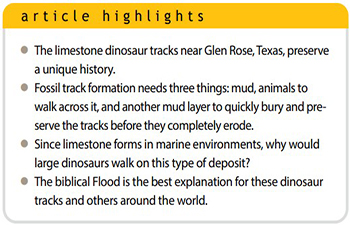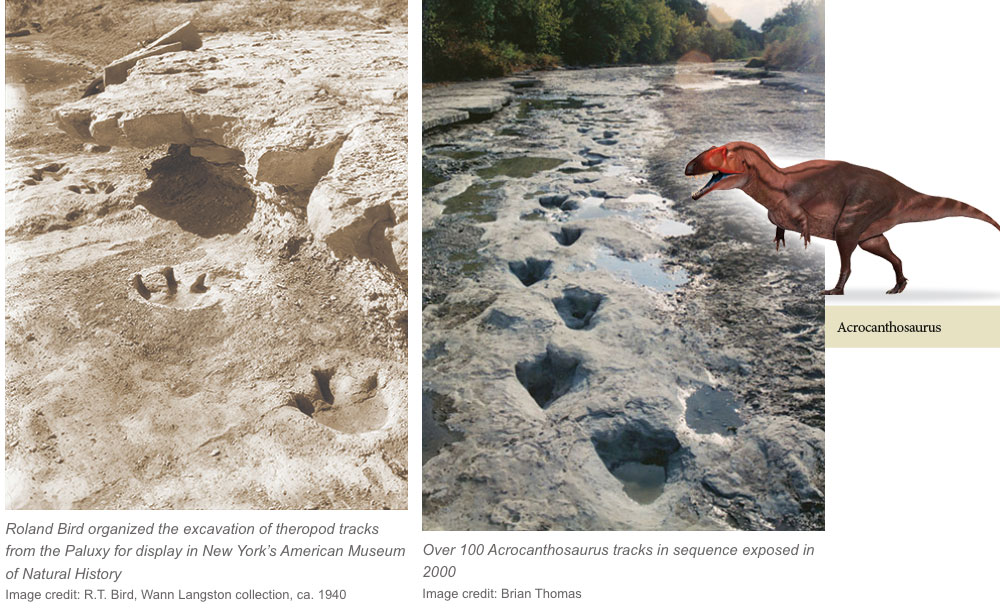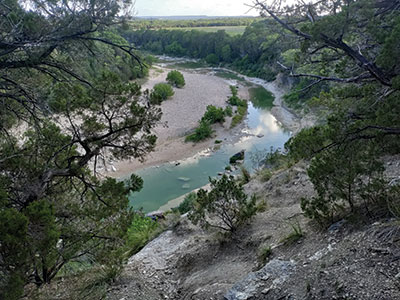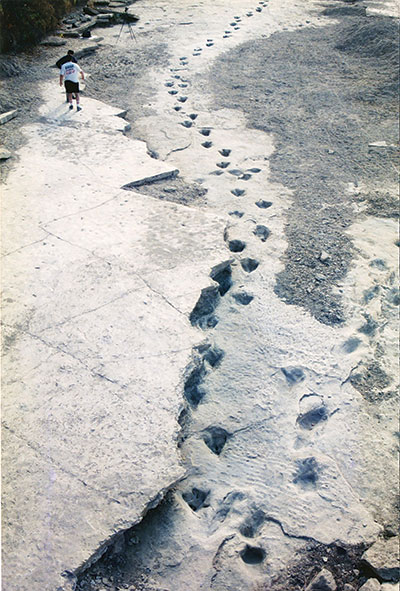by Brian Thomas, Ph.D., and Tim Clarey, Ph.D.*
 A bend in the Paluxy River winds through Dinosaur Valley State Park near Glen Rose, Texas. Turtles, fishes, moss, algae, and some snakes inhabit the waters flowing over flat limestone layers that preserve dinosaur footprints. Visitors might wonder when these large reptiles tromped through the lime mud that became the Glen Rose Formation. Park signs offer answers, but they reflect evolution’s willful ignorance of creation and the global Flood.1
A bend in the Paluxy River winds through Dinosaur Valley State Park near Glen Rose, Texas. Turtles, fishes, moss, algae, and some snakes inhabit the waters flowing over flat limestone layers that preserve dinosaur footprints. Visitors might wonder when these large reptiles tromped through the lime mud that became the Glen Rose Formation. Park signs offer answers, but they reflect evolution’s willful ignorance of creation and the global Flood.1
Two features of these dinosaur tracks show why the Flood that evolutionary thinking disallows is the key to explaining how they got there.
 Paluxy River Tracks
Paluxy River Tracks
I (Brian) remember in 2000 perching with my Pentax camera on a scaffold erected on the Paluxy riverbed. Dry weather had stopped the water’s flow, enabling creation researchers to expose over 130 Acrocanthosaurus footprints normally hidden beneath water-covered mud. What a sight! Another dry spell in 2022 allowed mainstream workers to re-expose the same trackway, this time for national news. Now, even more people know about the tracks creationists have been pondering for a few decades.2
Acrocanthosaurus resembled a tyrannosaur. As one of the biggest theropods, it left big tracks. But some spots have even larger prints. Visitors can touch a track or two that the enormous Sauroposeidon left on the west bank at the main track site. With its tall shoulders and long neck, “an adult Sauroposeidon could have peered through a six-story window.”3

First Flood Feature Fit
What does it take to preserve tracks? Key conditions include a soft surface, a trackmaker, then more sediment to cover it soon after. That sediment needs to flow at just the right pace—not so slow that the fresh tracks have time to collapse or erode, and not so fast that it destroys the tracks beneath.
This leads to our first feature that fits the Flood. Acrocanthosaurus walked on multiple layers.4 Each layer spread atop the one beneath like a vast pouring of pancake batter. If these layers happened fast, then the same animals could have made these tracks, one set atop another.5
Most lime is a marine (ocean) deposit. Where today does marine mud blanket flat ground over and over? Nowhere. A river flood might drop sediment in a valley, but not lime mud over the whole land. So, ocean sediments flooded the continent.
Second Flood Feature Fit

For some reason, dinosaurs walked over this marine mud. Why would dinosaurs have paced along shallow oceans? The Flood again explains this feature.
Such out-of-place behavior suggests a strange situation. Bear in mind that thousands of feet of Flood sediments lie beneath these track layers. Thus, these footprints occur near the top of the rising water phase of the Flood. These dinosaurs may have been some of the last living creatures outside Noah’s Ark. “And the waters prevailed on the earth one hundred and fifty days” (Genesis 7:24).
ICR’s global Flood model describes tsunami-like waves crashing across the land over and over as the floodwaters advanced.6 These would have made the rapidly stacked layers that we see. At some points during the Flood year, high-energy watery slurries went slack. The lower-energy waves were gentle enough to bury but not destroy fresh tracks and to leave ripple marks.

The tsunamis’ initial powerful waves could have washed these large dinosaurs off nearby pre-Flood wetlands and transported them alive to the Glen Rose area. Or they could have walked there during the early Flood and made tracks during lulls between each violent wave.7 We speculate that these dinosaurs left tracks wherever they could get their footing, desperate for rest. They could have tromped atop closely spaced layers in the same area as they walked across successive fresh marine sediments.
Did These Limestones Have Human Tracks?
In the late 1970s, ICR and other researchers scoured the Paluxy for better-quality examples of the few human-like tracks already known. The unique tracks lay next to and right inside a few theropod tracks. ICR’s 1980 book Tracking Those Incredible Dinosaurs stated that no known creature except a human makes narrow tracks like those.8
However, erosion over the next few years transformed the impressions into three-toed red stains. Integrity demanded that we recall the book, which we did in 1984. Then in 2013, scientists described narrow tracks inside dinosaur tracks from Australia as impressions of soft tissue pads on dinosaur soles.9 Dinosaur feet and forgeries now explain most examples of what we once thought were human-like tracks.
Conclusion
If you enjoy cooling off in the clear water while visiting Dinosaur Valley State Park in the summer, then watch your step on the slick algae bottom. Imagine the size of the animals that made these tracks. Then remember two features that point to Noah’s Flood. First, the Flood’s uniqueness helps explain stacks of tracks that do not form today. Second, lime muds are marine deposits, and dinosaurs didn’t belong in the seas.
Those waters must have overtopped the land, giving hardy dinosaurs wet places to walk before they finally perished in the Flood, just like the Bible says.
References
- 2 Peter 3 predicted that scoffers would be willfully ignorant of creation and the Flood.
- Thomas, B. Fresh Dinosaur Tracks Revive Rankling Mysteries. Creation Science Update. Posted on ICR.org September 19, 2022, accessed March 1, 2023.
- Hallett, M. and M. J. Wedel. 2016. The Sauropod Dinosaurs. Baltimore, MD: Johns Hopkins University Press, 47.
- This identification is probable because of the few Acrocanthosaurus skeletal remains discovered nearby.
- Since each layer sharply contacts the ones above and below it, even the short time required for erosion to carve ruts into the upper surfaces must not have elapsed.
- Clarey, T. 2020. Carved in Stone: Geological Evidence of the Worldwide Flood. Dallas, TX: Institute for Creation Research.
- Clarey, T. 2015. Dinosaur Fossils in Late-Flood Rocks. Acts & Facts. 44 (2): 16.
- Morris, J. D. 1980. Tracking Those Incredible Dinosaurs—and the People Who Knew Them. San Diego, CA: CLP Publishers.
- Romilio, A., R. T. Tucker, and S. W. Salisbury. 2013. Reevaluation of the Lark Quarry dinosaur tracksite (late Albian–Cenomanian Winton Formation, central-western Queensland, Australia): no longer a stampede? Journal of Vertebrate Paleontology. 33 (1): 102-120.
*Dr. Thomas is Research Scientist and Dr. Clarey is Director of Research at the Institute for Creation Research. Dr. Thomas earned his Ph.D. in paleobiochemistry from the University of Liverpool, and Dr. Clarey earned his Ph.D. in geology from Western Michigan University.



